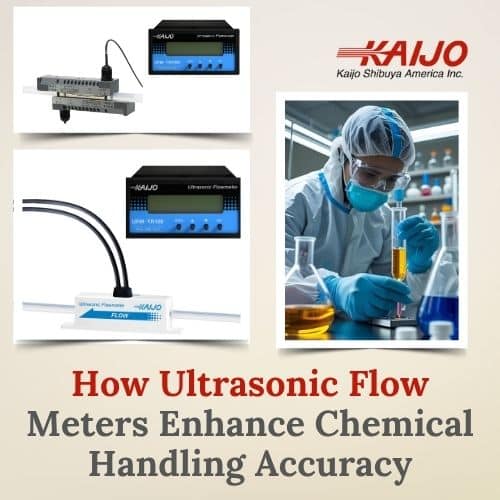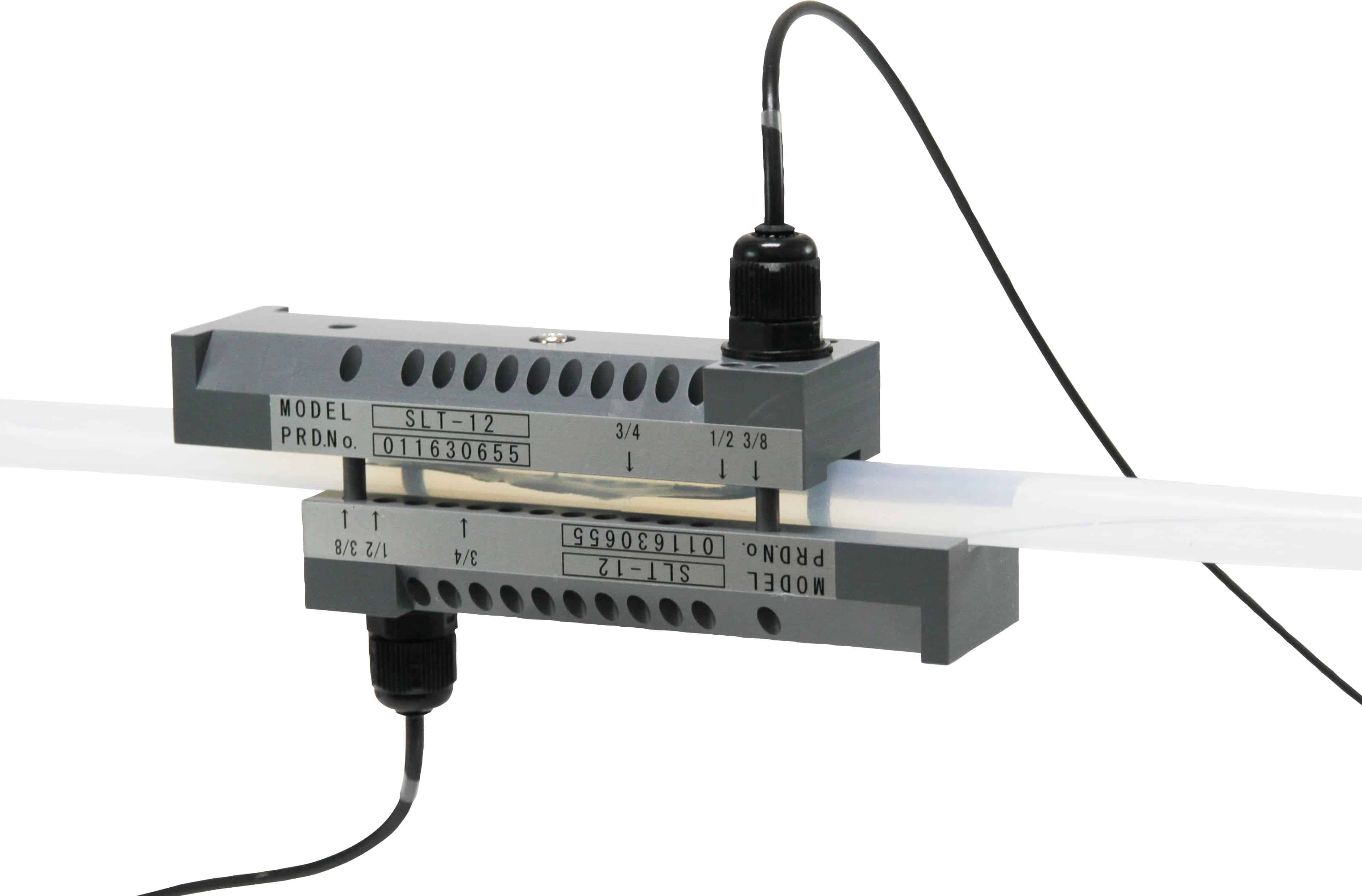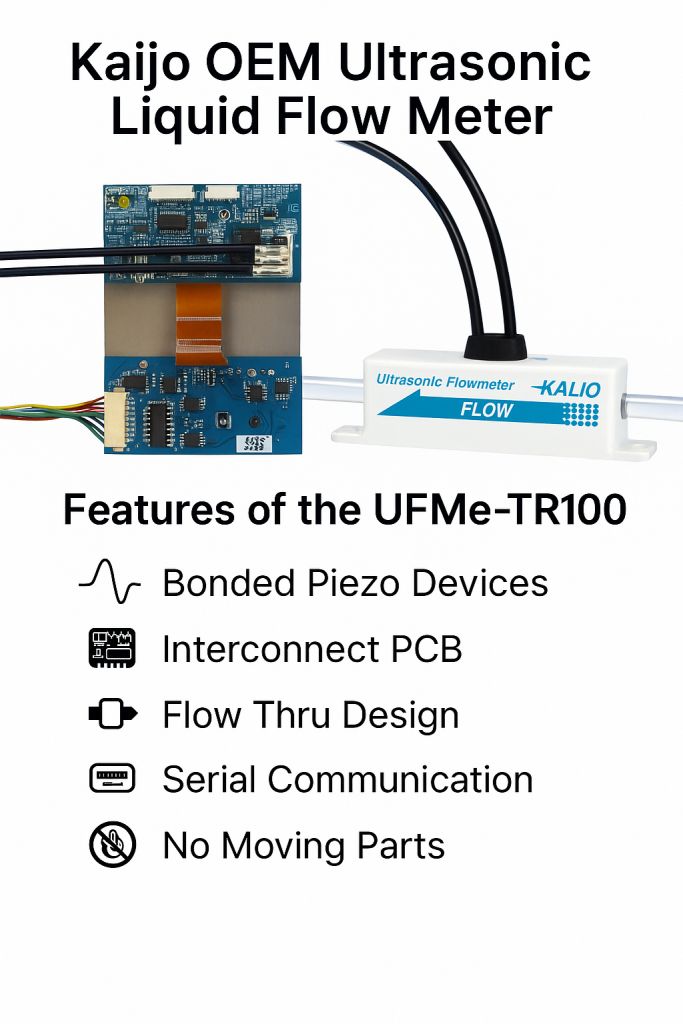How Ultrasonic Flow Meters Enhance Chemical Handling Accuracy
Written by: Michael Danese | July 8, 2025
 Summary: This article details how Kaijo’s ultrasonic liquid flow meters deliver unmatched precision, reliability, and regulatory compliance for managing aggressive and slurry-based chemicals in semiconductor and industrial manufacturing.
Summary: This article details how Kaijo’s ultrasonic liquid flow meters deliver unmatched precision, reliability, and regulatory compliance for managing aggressive and slurry-based chemicals in semiconductor and industrial manufacturing.
Table of Contents
- Why Accuracy in Chemical Handling Matters.
- Challenges in Managing Aggressive and Slurry-Based Chemicals.
- How Ultrasonic Liquid Flow Meters Work.
- Why Ultrasonic Meters Excel with Slurry Chemicals.
- Kaijo’s OEM-Ready Flow Meter Option.
- Use Cases in Semiconductor and Chemical Manufacturing.
- Why Choose Kaijo Over Other Ultrasonic Equipment Manufacturers.
- Ready to Optimize Your Chemical Flow Monitoring?
1. Why Accuracy in Chemical Handling Matters
For manufacturing and process engineers, even a minor error in chemical flow can mean wasted batches, unscheduled downtime, or missed compliance targets. The impact is especially significant when handling aggressive chemicals and slurry-based solutions, where incorrect flow monitoring can lead to damage to equipment, compromise product quality, and result in safety incidents.
What’s at stake?
- Product quality: Small deviations in flow rate can lead to defects or entire batches falling out of the required specification.
- Operational efficiency: Inaccurate measurements create bottlenecks, increase scrap, and disrupt production schedules.
- Compliance: Failure to monitor chemicals precisely can result in violations of strict industrial regulations.
Industry Insight:
The demand for accurate, non-invasive chemical flow monitoring is surging in chemical-intensive sectors. According to Mordor Intelligence, the global ultrasonic flow meter market is projected to increase from $1.52 billion in 2025 to $2.14 billion by 2030, indicating a shift toward advanced and reliable solutions.
Manufacturing and process engineers are turning to cutting-edge ultrasonic liquid flow meter technology as a strategic investment. These systems support goals such as minimizing downtime, maintaining process consistency, and simplifying regulatory compliance, resulting in higher output, better quality, and sustained operational excellence.
2. Challenges in Managing Aggressive and Slurry-Based Chemicals
Accurate chemical flow monitoring can be challenging with standard fluids, but when aggressive or slurry-based chemicals are added to the mix, the obstacles multiply. Traditional flow meters often create more problems than they solve, introducing new points of failure and operational headaches.
Common Challenges Include:
- Sensor Degradation and Clogging: Corrosive chemicals and abrasive particulates quickly wear down or block traditional sensors, leading to frequent failures and inaccurate readings.
- High Maintenance and Downtime: Regular cleaning, recalibration, and replacement of in-line sensors disrupt production and drain maintenance resources, increasing operational costs.
- Process Contamination Risk: Contact-based sensors can introduce contaminants into process streams, compromising product purity and leading to costly cross-batch issues, particularly in semiconductor manufacturing.
- Measurement Drift and Inconsistency: Accumulated sediment and sensor wear cause readings to drift over time, making it hard for engineers to trust their flow data or maintain tight process control.
- Flow Disturbance: Insertion and inline meters can disrupt fluid dynamics, resulting in uneven slurry distribution or turbulence that further compromises measurement reliability.
What does this mean for engineers?
- Unplanned downtime and emergency maintenance are common.
- Long-term measurement precision is compromised.
- Safety and compliance risks increase.
- Operational costs climb, with value lost to avoidable process interruptions.
These persistent challenges underscore the need for robust, non-invasive flow monitoring solutions that maintain measurement integrity and ensure the smooth operation of harsh chemical processes.
3. How Ultrasonic Liquid Flow Meters Work
Ultrasonic liquid flow meters offer a non-invasive and precise solution to chemical flow measurement challenges. Instead of being placed inside the pipe, ultrasonic sensors are designed to clamp on and attach to the outside, eliminating any exposure to aggressive chemicals or slurries.
Core Operating Principle:
The system transmits high-frequency sound waves through the pipe wall and the process fluid. By comparing the time it takes for sound waves to travel upstream and downstream, the meter calculates flow rate with high precision, without ever coming into contact with the liquid.
Key Advantages for Engineers:
- No Process Interruption: Install or service sensors without shutting down production lines or draining chemicals, keeping operations moving and maintenance simple.
- Zero Contamination or Corrosion: External mounting means the sensor is never exposed to corrosive substances or abrasive particles, dramatically reducing maintenance needs.
- Stable and Reliable: No moving parts, so accuracy doesn’t drift over time and recalibration is rarely needed.
- Unmatched Flexibility: Clamp-on transducers can be repositioned easily for calibration, troubleshooting, or temporary flow checks, adapting to changing process requirements.
- Consistent Accuracy: Immune to fluctuations in temperature and pressure that affect traditional sensors.
Refer to the diagram below, which illustrates a typical clamp-on ultrasonic sensor installation.
This innovative, non-intrusive approach makes ultrasonic flow meters the ideal choice for engineers who require dependable measurement and minimal maintenance, especially in environments where aggressive or difficult-to-handle chemicals are present.
4. Why Ultrasonic Meters Excel with Slurry Chemicals
Slurry chemical monitoring is a notorious challenge for engineers. Traditional flow meters are prone to clogging, rapid abrasion, and frequent breakdowns. Ultrasonic liquid flow meters, however, take a completely different approach, delivering reliable performance regardless of the slurry’s thickness or abrasiveness.
Engineer-Proven Benefits:
- No Clogs or Wear: Sensors mount on the outside of pipes, safe from abrasive particles and buildup. This means continuous operation with zero sensor blockages and virtually no unplanned maintenance.
- Consistent Accuracy in Harsh Conditions: Whether you’re working with fine semiconductor polishing slurries or dense mineral mixtures, ultrasonic meters provide stable readings, unaffected by changes in particle size or concentration.
- Zero Downtime for Cleaning: Forget about shutting down production to disassemble and clean sensors—since nothing touches the fluid, measurement remains uninterrupted.
- Handles Complex Flow Profiles: Advanced digital algorithms automatically adapt to variable flow rates and densities, ensuring reliable data even as conditions change.
- Maintains Process Integrity: Unlike insertion meters, ultrasonic devices don’t disrupt slurry flow, so you avoid issues like particle settling or uneven distribution that can sabotage downstream processes.
By eliminating the vulnerabilities that limit traditional meters, ultrasonic liquid flow meters empower engineers to monitor slurry chemicals with confidence, by boosting uptime, reducing maintenance costs, and ensuring process consistency.
5. Kaijo’s OEM-Ready Flow Meter Option
Kaijo’s OEM flow meter is engineered for equipment manufacturers and integrators who need reliable and accurate flow measurement within their systems. With a compact and rugged design, it delivers Kaijo’s renowned ultrasonic accuracy while fitting easily into even the smallest or most complex equipment layouts.
OEM Advantages:
- Space-Saving Flexibility: The meter’s small footprint and adaptable mounting options simplify installation in limited spaces or dense control panels without compromising measurement quality.
- Factory-Calibrated Precision: Each flow meter is calibrated using NIST-traceable standards, ensuring dependable accuracy and simplifying compliance documentation for your quality systems.
- Plug-and-Play Compatibility: Supports a variety of analog and digital outputs, making integration with existing PLCs, controllers, or remote monitoring systems fast and straightforward.
- Custom Built for Your Needs: Collaborate with Kaijo’s engineers to specify measurement ranges, output formats, and mounting preferences tailored precisely to your application.
- Technical Support: OEM customers receive dedicated engineering assistance from concept through rollout, including integration guidance and troubleshooting support.
- Quality You Can Trust: Every unit undergoes extensive performance and environmental testing before shipping, ensuring confidence in both accuracy and durability at scale.
For detailed technical specifications or application advice, connect directly with Kaijo’s support team to accelerate your integration process and reduce your time-to-market.
6. Use Cases in Semiconductor and Chemical Manufacturing
Kaijo’s ultrasonic liquid flow meters are relied on in critical manufacturing environments where accuracy, reliability, and minimal maintenance are essential. Below are key industry scenarios that highlight the impact of Kaijo’s technology:
Chemical Mechanical Planarization (CMP) Processes
- Before Kaijo: Engineers struggled with frequent sensor clogs and maintenance interruptions, putting production schedules and wafer quality at risk.
- With Kaijo: Clamp-on, non-invasive flow meters provide continuous, clog-free monitoring of slurry flow, ensuring consistent processing and greater yield stability.
Photoresist Coating Systems
- Before Kaijo: Traditional sensors experienced residue buildup, resulting in frequent downtime and variable film thickness.
- With Kaijo: Ultrasonic meters prevent sensor contamination, leading to uninterrupted coating operations and more accurate, uniform application.
Etching and Acid Delivery
- Before Kaijo: Corrosive chemicals rapidly degraded standard sensors, resulting in unpredictable measurements and elevated failure rates.
- With Kaijo: Non-contact ultrasonic measurement offers dependable, corrosion-free flow monitoring, delivering precise control in aggressive chemical applications.
Chemical Waste Treatment
- Before Kaijo: Fouled sensors and drift complicated compliance reporting and process reliability.
- With Kaijo: Maintenance-free ultrasonic meters provide accurate, stable flow data, streamlining regulatory compliance and improving waste management efficiency.
Across semiconductor and industrial chemical manufacturing, process engineers rely on Kaijo’s ultrasonic solutions to minimize unscheduled downtime, reduce maintenance requirements, and maintain complete confidence in their chemical flow data at every stage of production.
7. Why Choose Kaijo Over Other Ultrasonic Equipment Manufacturers
Kaijo sets itself apart with precision engineering, deep application expertise, and purpose-built solutions for the most demanding industrial and semiconductor environments.
Competitive Advantages:
- Low-Flow Precision: Kaijo’s advanced transducer and signal processing technology deliver reliable measurements even at the low flow rates common in high-tech manufacturing.
- Engineered for Harsh Environments: Years of experience with slurries, abrasive particles, and aggressive chemicals mean Kaijo meters maintain consistent accuracy where generic brands might fail.
- Full OEM Integration Support: Kaijo doesn’t just ship hardware—its experts collaborate directly with OEM partners from design to deployment, ensuring seamless integration, custom configurations, and rapid troubleshooting.
- Tailored Solutions: Every meter can be customized for specific application needs, including mounting options, output formats, and measurement ranges, to ensure a perfect technical fit.
- Proven Industry Track Record: Backed by decades of field experience and trusted by leading semiconductor and chemical manufacturers, Kaijo delivers performance customers can trust.
- Stringent Quality Assurance: Each unit undergoes extensive testing for durability, electrical interference, and resistance to environmental extremes, ensuring stability and a long service life.
Engineers and OEM integrators rely on Kaijo for more than just ultrasonic instruments. They trust a true technical partner dedicated to delivering practical results, supporting innovation, and driving operational excellence throughout the project lifecycle.
8. Ready to Optimize Your Chemical Flow Monitoring?
If you’re looking to improve process reliability, reduce maintenance hassles, and achieve consistent, accurate chemical flow monitoring, it’s time to upgrade to Kaijo’s ultrasonic liquid flow meter technology.
Kaijo’s team collaborates closely with process engineers, manufacturing professionals, and OEM integrators to assess application needs, streamline installations, and deliver tailored solutions, whether you’re facing aggressive chemicals, complex slurries, or tight integration timelines.
Next Steps:
- Connect directly with a Kaijo expert for a custom application review and technical consultation.
- Request detailed technical specifications and integration guidance for your upcoming project.
- Book a demonstration to see how Kaijo’s ultrasonic flow meters perform in your process environment.
Take the first step toward more efficient, reliable chemical flow monitoring. Contact Kaijo today and leverage world-class expertise in your facility.
Frequently Asked Questions
1. How can advanced data analysis improve the accuracy and reliability of flow monitoring for aggressive and slurry-based chemicals?
Ultrasonic flow meters, combined with advanced data analysis, provide precise real-time and historical measurements. This approach enables users to detect measurement drift, inconsistencies, or abnormal flow conditions, ensuring more reliable monitoring and facilitating prompt adjustments. The result is higher product quality and reduced waste, even when handling challenging chemicals or slurry mixtures.
2. How can flow monitoring equipment help predict and prevent unplanned maintenance or calibration issues?
Ultrasonic flow meters continuously monitor flow data, allowing for the identification of trends such as sensor degradation, blockages, or calibration drift. This enables maintenance teams to address issues proactively, scheduling service before failures occur and reducing the risk of unexpected production interruptions.
3. In what ways do advanced monitoring solutions support compliance with industry regulations and process quality documentation for audits?
Ultrasonic flow meters can automatically log and organize flow data, making it easy to identify any deviations from compliance requirements. The meters facilitate the creation of detailed reports and maintain accurate traceability records, simplifying the process of demonstrating regulatory compliance and consistent process quality during audits.







